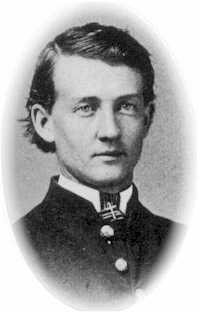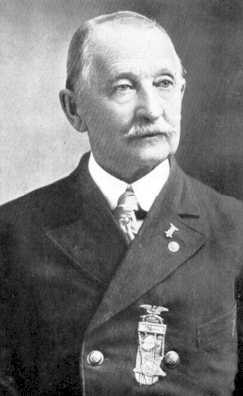|
1863 Civil War Diary: Osborn H. I.
Oldroyd Hinds County Gazette, April 12, 2001
Of slavery, Oldroyd expressed that he wanted all men held in bondage set free. However, he worried that many of the blacks would be leaving good homes in search of unfulfilled dreams. Of the South in general, he noted the lack of schoolhouses and determined that the poor whites as well as the blacks were not receiving a proper education. He often commented on the soldiers' love of coffee. He even commiserated on the misery of getting 'chiggers' while blackberry picking. And, in one rare confession, he wrote that he was quite intrigued by the concept of plantation life. Of the Union Army, led by Grant, McPherson, Logan, and Sherman, he bragged of never being defeated. His bragging came with good cause. General Grant's army won every battle associated with the Campaign for Vicksburg. Following the Vicksburg Campaign, Oldroyd re-enlisted but was not physically fit for duty. His asthma kept him in and out of the Regimental Hospital. In May of 1864, he was admitted to the U. S. A. Hospital in Mound City, Illinois, complaining of intermittent fever. One year later, in 1865, he was mustered out. War records show that he was a faithful soldier -- absent only when he had to be admitted to the hospital for treatment of chronic asthma. Many of his companions were killed during the Battles of Raymond, Champion Hill, Big Black River, and Vicksburg, including his beloved bunkmate and friend Corporal John Calvin Waddell, who was killed in the Battle of Raymond. Following the war, Oldroyd returned to Ohio where he was Steward of the National Soldiers' Home in Dayton, Ohio. Friends lovingly referred to him as 'Captain' or 'Colonel'. Others simply called him 'Ozzie'. In 1873, at the age of thirty-one, Oldroyd married Lida A. Stoneberger. The couple had one daughter, Daisy. During this time, Oldroyd began to actively pursue a hobby that he had begun as early as 1860, collecting Abraham Lincoln memorabilia. What started as a simple hobby eventually turned into an all-consuming passion. Oldroyd and his family moved to Springfield, Illinois, and soon rented the home of President Lincoln. In 1884, he turned, the home into The Lincoln Museum, charging the public to view the Oldroyd Lincoln Memorial Collection. The museum was a successful venture and his collection continued to grow in size. In 1893, after the Lincoln home was donated to the State of Illinois, he moved his mammoth collection to Washington, D. C. -- to the Petersen House where Abraham Lincoln died. With the permission of the government, Oldroyd and his family lived in this home rent-free. The price for viewing his Lincoln memorabilia was twenty- five cents. In 1917, he wrote and published The Assassination of Abraham Lincoln, detailing the murder and death of his hero. Overnight, the book became one of the best sellers of the time.
Osborn Oldroyd in
later years displaying his Grand Army of the Republic medal. The Washington Post announced the purchase on May 2, 1926, with a banner headline that read, "Gets Storehouse of Lincoln Relics: Government Action Assures Preservation of Oldroyd Collection Here." The news column further stated, "Captain Oldroyd has been gathering the collection for 63 years, having started on this patriotic work of love for his chieftain soon after he was released from service in the internecine strife. Mr. Oldroyd is now 80 years old. Having for years been a student of Lincoln, acting as guide for his collection all through its formation, Capt. Oldroyd has become a rich source of Lincoln traditions. Passage by Congress of the measure authorizing tile purchase of the Oldroyd collection, 3, 000 authentic Lincoln mementos now on display in the historic Petersen House where the martyred president died, will preserve for future generations making pilgrimages to Washington a great store house of materials identified with Lincoln tradition." The exhibit was eventually moved across the street to Ford's Theatre, the site of Lincoln's assassination. Here the Oldroyd Lincoln Memorial Collection found its permanent home. Sadly, Oldroyd had only a short time to enjoy the financial success gained from the purchase of his beloved collection. In February of 1929, he applied for a pension, citing bid age and senility. At the time, his health was so feeble that he could scarcely write his name on the designated form. Oldroyd passed away in October of 1930 at the age of eighty-eight. His beloved wife Lida outlived him by four years. Oldroyd's interest in Abraham Lincoln and collecting Lincoln memorabilia was the focal point of his life. Two rare books, A Soldier's Story of the Siege of Vicksburg and The Life of Osborn H. Oldroyd: Founder and Collector of Lincoln Mementos, tell his story. He was a man who fought hard for the cause of the Union then did everything in his power to preserve the honor and memory of the sixteenth president of the United States, Abraham Lincoln. He led a long and productive life, continuing with his talent for writing to the very end. Three months before his death in 1930, at the age of eighty-eight, he put his 'pen to paper' one last time, writing an expression of heartfelt gratitude: "Words of cheer and handclasps warm, fragrant flowers and music's charm, Reminiscences of days gone by, Ah, surely none so blest as I." On a cool fall day in October, the old soldier, faithful to the Union, was laid to rest leaving his wife, daughter, and grandchildren to mourn his death. To his family he left a lifetime of memories. To his comrades in war, Blue and Gray, he left a heart that sought to unite rather than to divide. To the world, he left his writings and the treasured collection of Abraham Lincoln mementos. This was his legacy.
| Home
| Grant's
March | Gregg's March | Battle of Raymond | Order of Battle | Commanders
| Soldiers
Who Fought | Diaries & Accounts | Copyright (c) James and Rebecca Drake, 1998 - 2002. All Rights Reserved. |
 Sergeant Osborn Oldroyd, whose
initials spell OHIO, was only nineteen years old when he enlisted with
the 2Oth Ohio Volunteer Infantry. He joined the Union Army at Camp
Chase, Ohio, on October 15, 1861, and was mustered out of the same camp
on July 19, 1865. During the years he spent in the Union Army, he
recorded historical data as well as personal observations of the war.
His book, A Soldier's Story of the Siege of Vicksburg, published
in 1885, gives a sixty-five day account of the Vicksburg Campaign --
beginning May I, 1863, after Grant landed his army on the east bank of
the Mississippi River, and ending July 4, 1863, with the surrender of
Vicksburg.
Sergeant Osborn Oldroyd, whose
initials spell OHIO, was only nineteen years old when he enlisted with
the 2Oth Ohio Volunteer Infantry. He joined the Union Army at Camp
Chase, Ohio, on October 15, 1861, and was mustered out of the same camp
on July 19, 1865. During the years he spent in the Union Army, he
recorded historical data as well as personal observations of the war.
His book, A Soldier's Story of the Siege of Vicksburg, published
in 1885, gives a sixty-five day account of the Vicksburg Campaign --
beginning May I, 1863, after Grant landed his army on the east bank of
the Mississippi River, and ending July 4, 1863, with the surrender of
Vicksburg.